Scenario Simulation for the Urban Carrying Capacity Based on System Dynamics Model in Shanghai, China
Abstract
:1. Introduction
2. Materials and Methods
2.1. Study Area
2.2. Data Sources
2.3. System Dynamics Model
3. Establishing the Evaluation Index System and SD Model for the UCC in Shanghai
3.1. SD model Formulation
3.1.1. Social Subsystem
3.1.2. Economic Subsystem
3.1.3. Environment Subsystem
3.2. Evaluation Index System
3.3. Multi-Scenarios Setting
3.4. Testing Effectiveness of the Model
4. Simulation Results under the Different Scenarios
4.1. Carrying Population Simulation
4.2. GDP Simulation
4.3. Urban Green Ecological Index Simulation
4.4. Simulation of Added Value of Secondary Industry
5. Discussion
- (1)
- Urban carrying capacity is a complex, multi-factor system. Although this study involves as many relevant influencing factors as possible, it still cannot cover all of them. Some influencing factors, such as land subsidence on the carrying population, have been simplified or not taken into account.
- (2)
- Four indicators were used to represent the level of urban carrying capacity of urban population, economy and ecology. In subsequent studies, land change can be integrated into the model for simulation of urban land change.
6. Conclusions
Author Contributions
Funding
Institutional Review Board Statement
Informed Consent Statement
Data Availability Statement
Acknowledgments
Conflicts of Interest
References
- Zou, H.; Ma, X. Identifying resource and environmental carrying capacity in the Yangtze River Economic Belt, China: The perspectives of spatial differences and sustainable development. Environ. Dev. Sustain. 2021, 23, 14775–14798. [Google Scholar] [CrossRef]
- Zhang, Y.; Wei, Y.; Zhang, J. Overpopulation and urban sustainable development—Population carrying capacity in Shanghai based on probability-satisfaction evaluation method. Environ. Dev. Sustain. 2021, 23, 3318–3337. [Google Scholar] [CrossRef]
- Bao, H.; Wang, C.; Han, L.; Wu, S.; Lou, L.; Xu, B.; Liu, Y. Resources and Environmental Pressure, Carrying Capacity, And Governance: A Case Study of Yangtze River Economic Belt. Sustainability 2020, 12, 1576. [Google Scholar] [CrossRef] [Green Version]
- Bibri, S.E.; Krogstie, J.; Kärrholm, M. Compact city planning and development: Emerging practices and strategies for achieving the goals of sustainability. Dev. Built Environ. 2020, 4, 100021. [Google Scholar] [CrossRef]
- Lin, S.; Sun, J.; Marinova, D.; Zhao, D. Effects of Population and Land Urbanization on China’s Environmental Impact: Empirical Analysis Based on the Extended STIRPAT Model. Sustainability 2017, 9, 825. [Google Scholar] [CrossRef] [Green Version]
- Yang, G.; Dong, Z.; Feng, S.; Li, B.; Sun, Y.; Chen, M. Early warning of water resource carrying status in Nanjing City based on coordinated development index. J. Clean. Prod. 2021, 284, 124696. [Google Scholar] [CrossRef]
- Shi, Y.; Shi, S.; Wang, H. Reconsideration of the methodology for estimation of land population carrying capacity in Shanghai metropolis. Sci. Total. Environ. 2019, 652, 367–381. [Google Scholar] [CrossRef]
- Li, J.; Liu, Z.; He, C.; Yue, H.; Gou, S. Water shortages raised a legitimate concern over the sustainable development of the drylands of northern China: Evidence from the water stress index. Sci. Total Environ. 2017, 590–591, 739–750. [Google Scholar] [CrossRef]
- Zheng, B.; Tong, D.; Li, M.; Liu, F.; Hong, C.; Geng, G.; Li, H.; Li, X.; Peng, L.; Qi, J.; et al. Trends in China’s anthropogenic emissions since 2010 as the consequence of clean air actions. Atmos. Chem. Phys. 2018, 18, 14095–14111. [Google Scholar] [CrossRef] [Green Version]
- Khan, A.H.; López-Maldonado, E.A.; Alam, S.S.; Khan, N.A.; López, J.R.L.; Herrera, P.F.M.; Abutaleb, A.; Ahmed, S.; Singh, L. Municipal solid waste generation and the current state of waste-to-energy potential: State of art review. Energy Convers. Manag. 2022, 267, 115905. [Google Scholar] [CrossRef]
- Rees, W.E. Ecological footprints and appropriated carrying capacity: What urban economics leaves out. Environ. Urban. 1992, 4, 121–130. [Google Scholar] [CrossRef]
- Cao, X.; Shi, Y.; Zhou, L. Research on Urban Carrying Capacity Based on Multisource Data Fusion—A Case Study of Shanghai. Remote Sens. 2021, 13, 2695. [Google Scholar] [CrossRef]
- Shi, Y.; Wang, H.; Yin, C. Evaluation method of urban land population carrying capacity based on GIS—A case of Shanghai, China. Comput. Environ. Urban Syst. 2013, 39, 27–38. [Google Scholar] [CrossRef]
- Wang, K.; Cai, Z.; Xu, Y.; Zhang, F. Hexagonal cyclical network structure and operating mechanism of the social-ecological system. Ecol. Indic. 2022, 141, 109099. [Google Scholar] [CrossRef]
- Plumb, G.E.; White, P.J.; Coughenour, M.B.; Wallen, R.L. Carrying capacity, migration, and dispersal in Yellowstone bison. Biol. Conserv. 2009, 142, 2377–2387. [Google Scholar] [CrossRef]
- Zhao, W.; Jiang, C.J.; Li, X.Y. Study on influence effect and coupling coordination of dynamic factors of urban land carrying capacity based on VAR model. J. Henan Agric. Univ. 2019, 53, 926–933. (In Chinese) [Google Scholar]
- Tang, Y.; Yuan, Y.; Zhong, Q. Evaluation of Land Comprehensive Carrying Capacity and Spatio-Temporal Analysis of the Harbin-Changchun Urban Agglomeration. Int. J. Environ. Res. Public Health 2021, 18, 521. [Google Scholar] [CrossRef]
- Song, X.M.; Kong, F.Z.; Zhan, C.S. Assessment of Water Resources Carrying Capacity in Tianjin City of China. Water Resour. Manag. 2011, 25, 857–873. [Google Scholar] [CrossRef]
- Yan, G.Q.; He, Y.C.; Zhang, X.H. Green Technology Progress, Agricultural Economic Growth and Pollution Space Spillover Effect: Evidence of Agricultural Water Utilization Process in China. Resour. Environ. Yangtze Basin 2019, 28, 129–143. (In Chinese) [Google Scholar]
- Pu, J.-W.; Zhao, X.-Q.; Miao, P.-P.; Li, S.-N.; Tan, K.; Wang, Q.; Tang, W. Integrating multisource RS data and GIS techniques to assist the evaluation of resource-environment carrying capacity in karst mountainous area. J. Mt. Sci. 2020, 17, 2528–2547. [Google Scholar] [CrossRef]
- Wu, X. An ecological environmental carrying capacity estimation of tourist attractions based on structural equation. Int. J. Environ. Technol. Manag. 2022, 25, 310–323. [Google Scholar] [CrossRef]
- Di, Q.B.; Han, S.S.; Han, Z.L. Spatial pattern of economic carrying capacity of cities at prefecture level and above in China. Geogr. Res. 2016, 35, 337–352. (In Chinese) [Google Scholar]
- Wang, D.; Ma, G.; Song, X.; Liu, Y. Energy price slump and policy response in the coal-chemical industry district: A case study of Ordos with a system dynamics model. Energy Policy 2017, 104, 325–339. [Google Scholar] [CrossRef]
- Zhou, Y.; Zhou, J. Urban atmospheric environmental capacity and atmospheric environmental carrying capacity constrained by GDP–PM2.5. Ecol. Indic. 2017, 73, 637–652. [Google Scholar] [CrossRef] [Green Version]
- Xing, X.G.; Shi, W.J.; Zhang, Y.D.; Xie, J.Y. Assessment of Groundwater Resources Carrying Capacity in Xi’an City Based on Principal Component Analysis. J. China Hydrol. 2013, 33, 35–38. (In Chinese) [Google Scholar]
- Zhang, J.; Zhang, C.; Shi, W.; Fu, Y. Quantitative evaluation and optimized utilization of water resources-water environment carrying capacity based on nature-based solutions. J. Hydrol. 2019, 568, 96–107. [Google Scholar] [CrossRef]
- Luo, M.; Huang, E.; Ding, R.; Lu, X. Research on water resources carrying capacity based on maximum supportable population. Fresenius Environ. Bull. 2019, 28, 100–110. [Google Scholar]
- Li, Y.; Huang, C.J.; Wang, K.; Wang, Y.T.; Zhang, D.H. Forest Ecological Carrying Capacity Evaluation and Gravity Center Transfer Analysis in Anhui Province. Resour. Environ. Yangtze Basin 2021, 30, 87–96. (In Chinese) [Google Scholar]
- Mashaly, A.F.; Fernald, A.G. Identifying Capabilities and Potentials of System Dynamics in Hydrology and Water Resources as a Promising Modeling Approach for Water Management. Water 2020, 12, 1432. [Google Scholar] [CrossRef]
- Zhu, X.Z.; Li, X.W.; Jia, K.J.; Qi, F. A Study on system dynamics of land comprehensive carrying capacity in Shanghai city. China Land Sci. 2014, 28, 90–96. (In Chinese) [Google Scholar]
- Barati, A.A.; Azadi, H.; Scheffran, J. A system dynamics model of smart groundwater governance. Agric. Water Manag. 2019, 221, 502–518. [Google Scholar] [CrossRef]
- Wang, G.; Xiao, C.; Qi, Z.; Meng, F.; Liang, X. Development tendency analysis for the water resource carrying capacity based on system dynamics model and the improved fuzzy comprehensive evaluation method in the Changchun city, China. Ecol. Indic. 2021, 122, 107232. [Google Scholar] [CrossRef]
- Zomorodian, M.; Lai, S.H.; Homayounfar, M.; Ibrahim, S.; Fatemi, E.; El-Shafie, A. The state-of-the-art system dynamics application in integrated water resources modeling. J. Environ. Manag. 2018, 227, 294–304. [Google Scholar] [CrossRef] [PubMed]
- Forrester, J.W. System dynamics, systems thinking, and soft OR. Syst. Dyn. Rev. 1994, 10, 245–256. [Google Scholar] [CrossRef]
- Zhou, J.; Chang, S.; Ma, W.; Wang, D. An unbalance-based evaluation framework on urban resources and environment carrying capacity. Sustain. Cities Soc. 2021, 72, 103019. [Google Scholar] [CrossRef]
- Aman, R.; Fang, C. Research on development models are suitable for water resources based on system dynamics model: Take Xinjiang as an example. Ecol. Econ. 2021, 37, 177–186. (In Chinese) [Google Scholar]
- Shad, M.; Sharma, Y.D.; Singh, A. Forecasting of monthly relative humidity in Delhi, India, using SARIMA and ANN models. Model. Earth Syst. Environ. 2022, 1–9. [Google Scholar] [CrossRef]
- Wang, C.; Hou, Y.; Xue, Y. Water resources carrying capacity of wetlands in Beijing: Analysis of policy optimization for urban wetland water resources management. J. Clean. Prod. 2017, 161, 1180–1191. [Google Scholar] [CrossRef]
- Ehrlich, C.; Noll, G.; Kalkoff, W.D.; Baumbach, G.; Dreiseidler, A. PM10, PM2.5 and PM1.0—Emissions from industrial plants—Results from measurement programmes in Germany. Atmos. Environ. 2007, 41, 6236–6254. [Google Scholar] [CrossRef]
- Xu, M.; Tan, R. Removing energy allocation distortion to increase economic output and energy efficiency in China. Energy Policy 2021, 150, 112110. [Google Scholar] [CrossRef]
- Sanjuan-Delmás, D.; Taelman, S.E.; Arlati, A.; Obersteg, A.; Vér, C.; Óvári, Á.; Tonini, D.; Dewulf, J. Sustainability assessment of organic waste management in three EU Cities: Analysing stakeholder-based solutions. Waste Manag. 2021, 132, 44–55. [Google Scholar] [CrossRef] [PubMed]
- Zhao, C.; Liu, M.; Du, H.; Gong, Y. The Evolutionary Trend and Impact of Global Plastic Waste Trade Network. Sustainability 2021, 13, 3662. [Google Scholar] [CrossRef]
- Shanghai Municipal People’s Government. Shanghai Master Plan 2017–2035. 2017. Available online: https://www.shanghai.gov.cn/nw42806/index.html (accessed on 17 January 2020).
- Safi, A.; Chen, Y.; Wahab, S.; Zheng, L.; Rjoub, H. Does environmental taxes achieve the carbon neutrality target of G7 economies? Evaluating the importance of environmental R&D. J. Environ. Manag. 2021, 293, 112908. [Google Scholar]

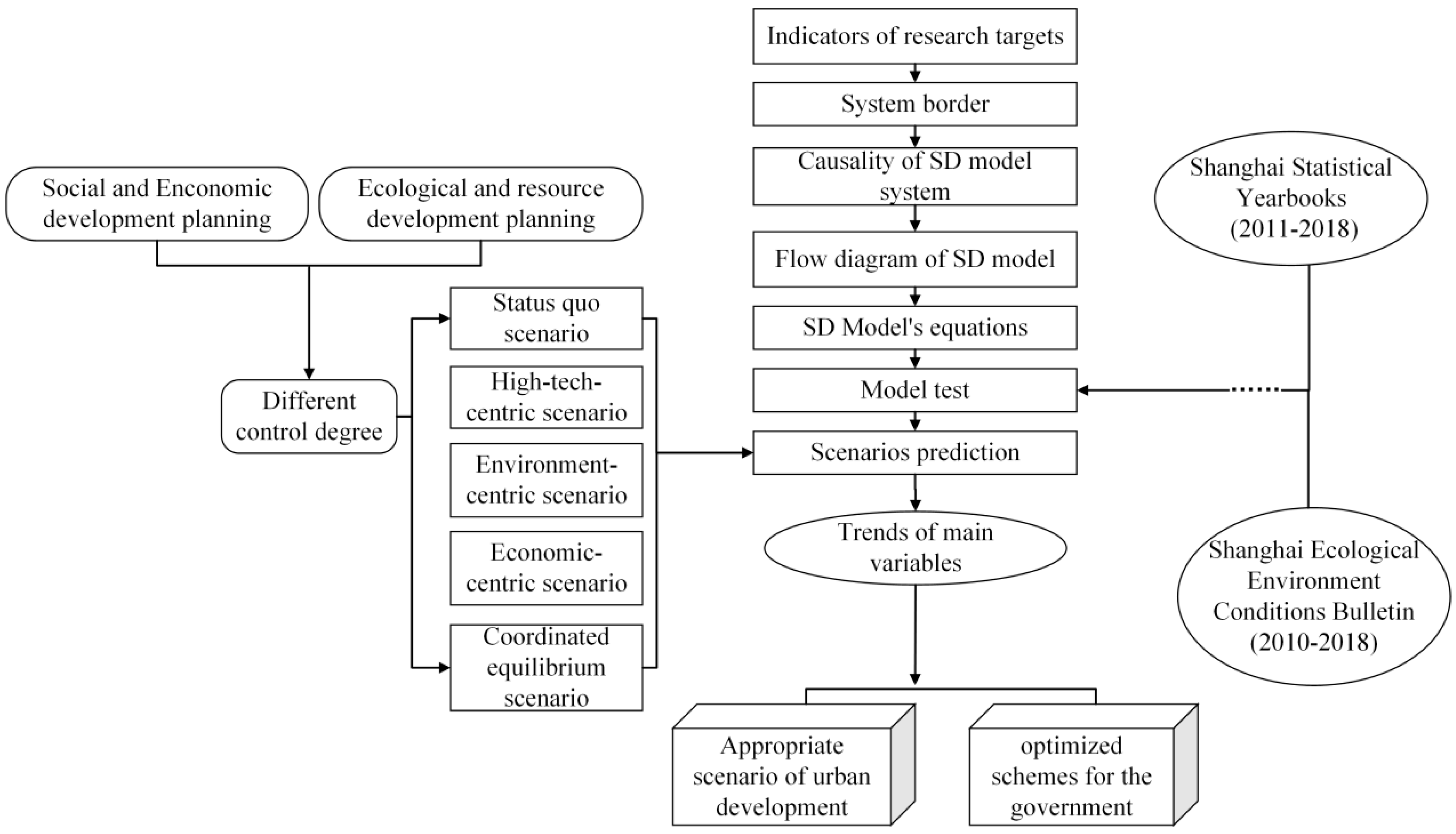
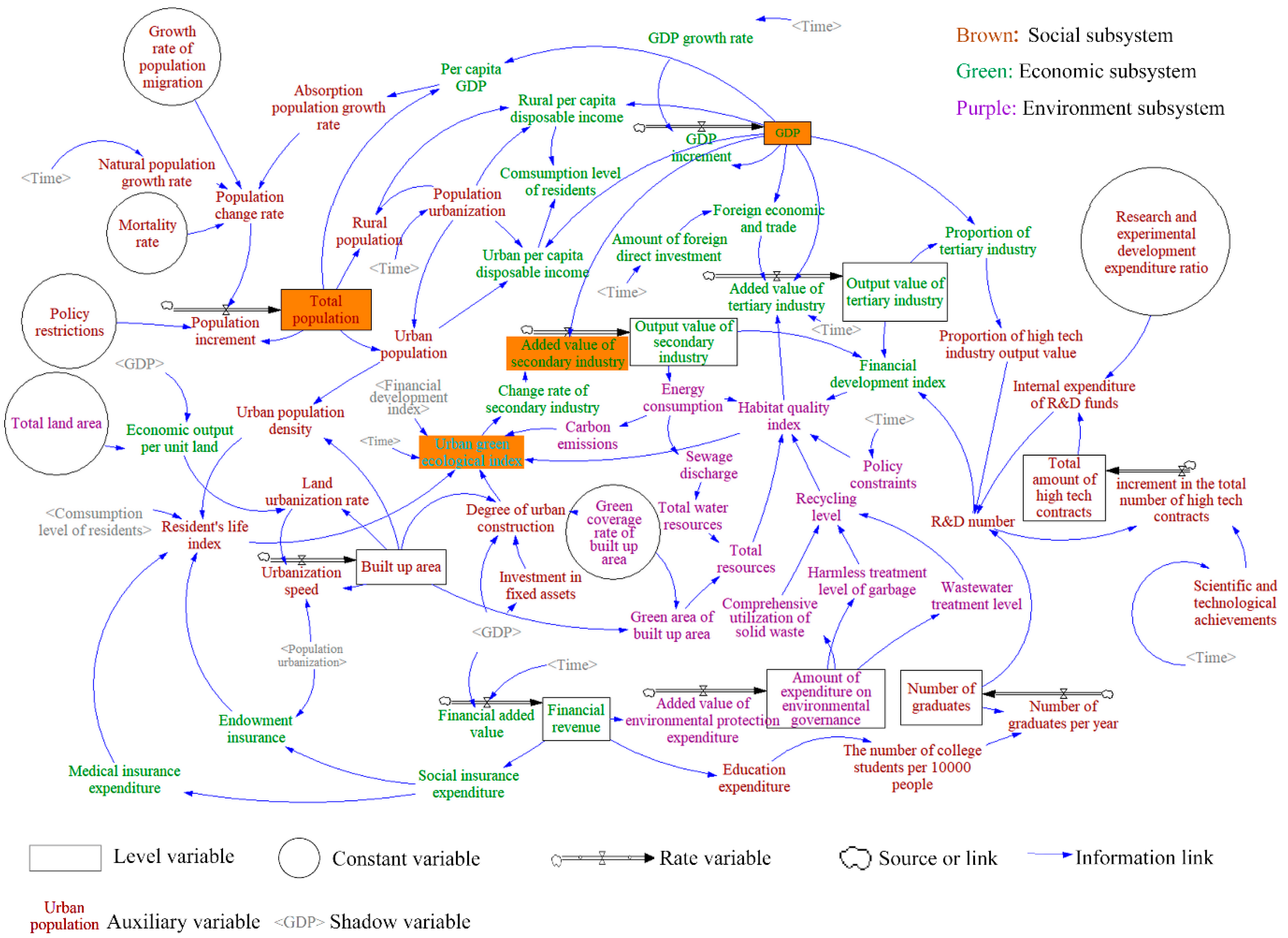
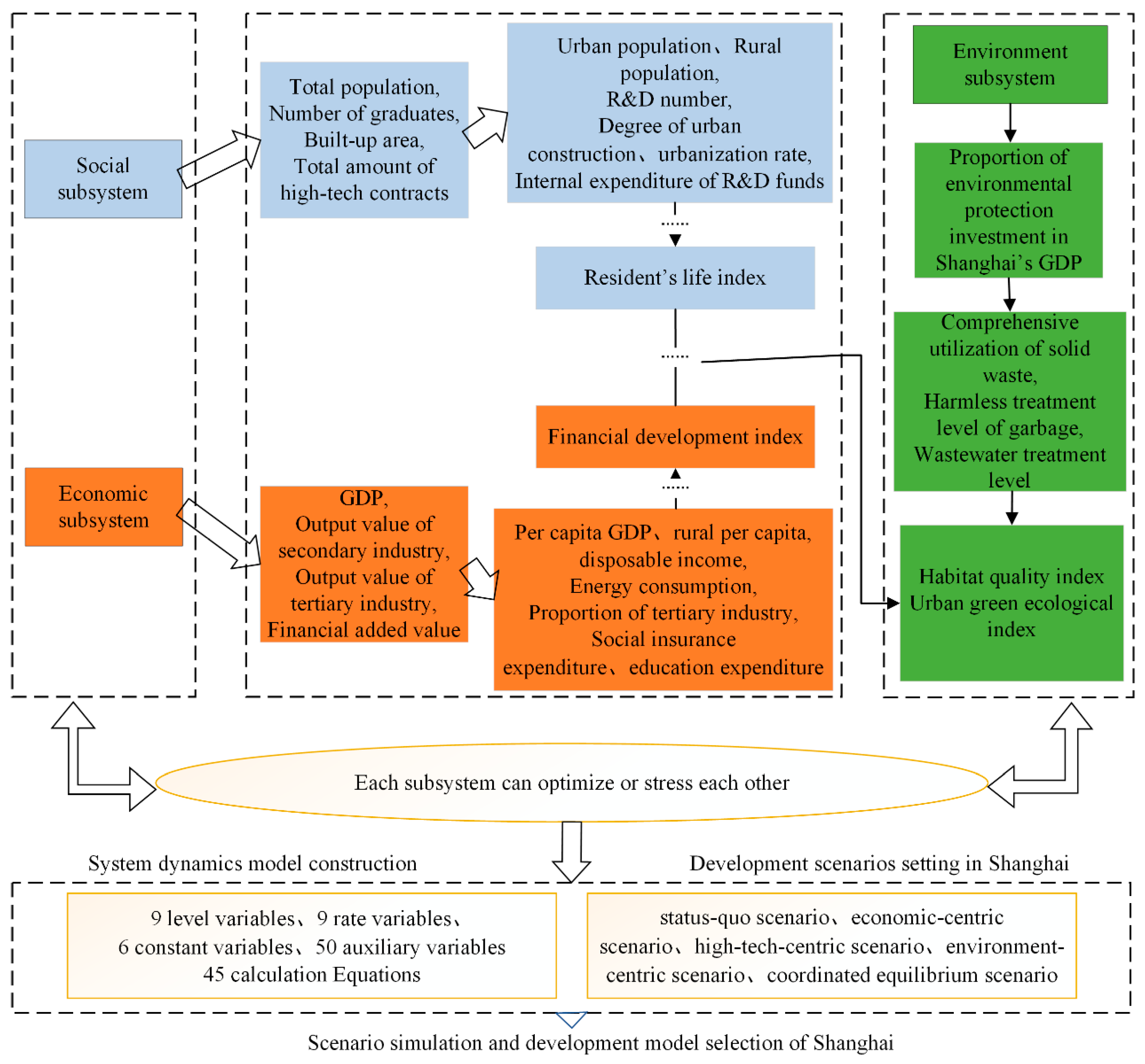
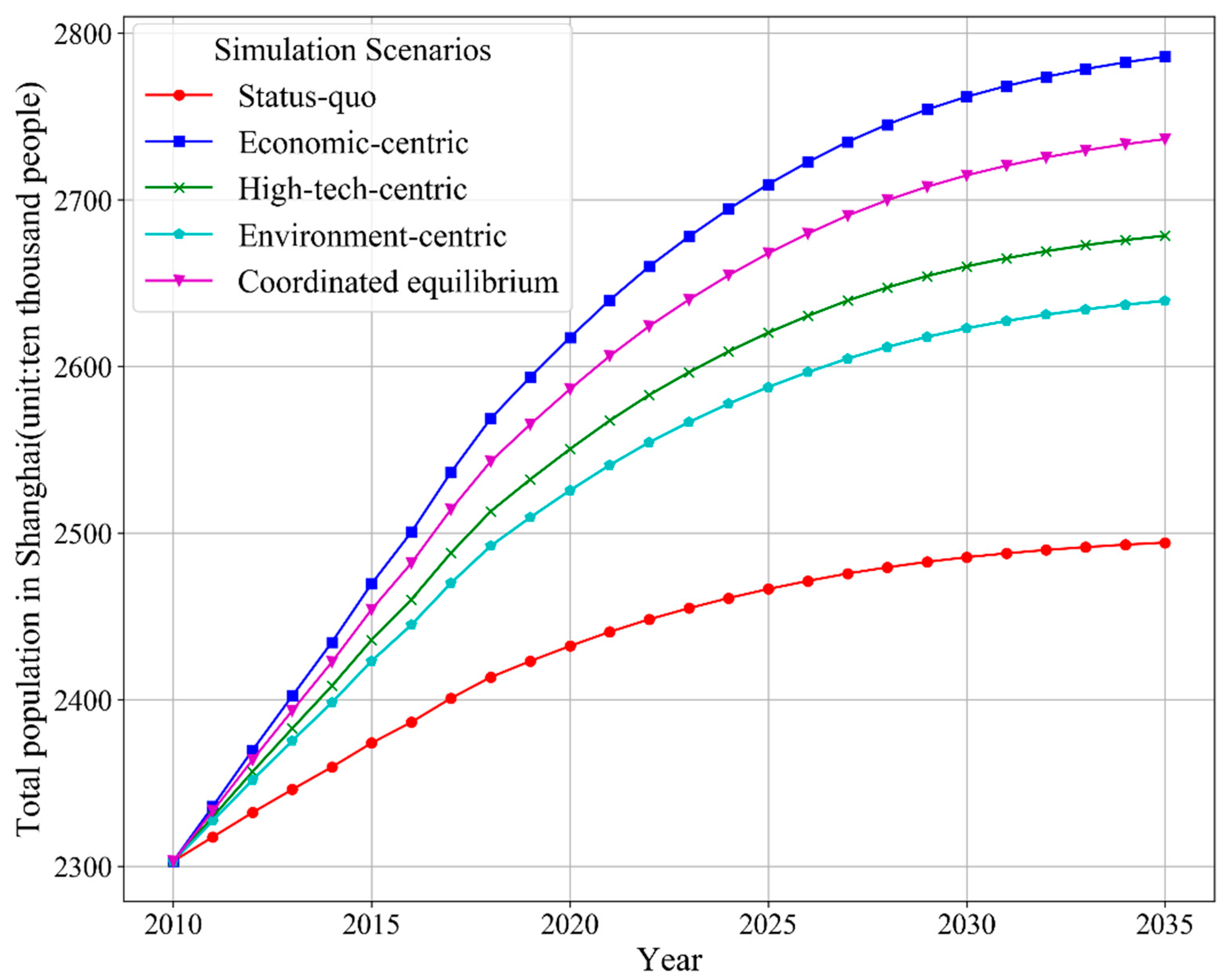
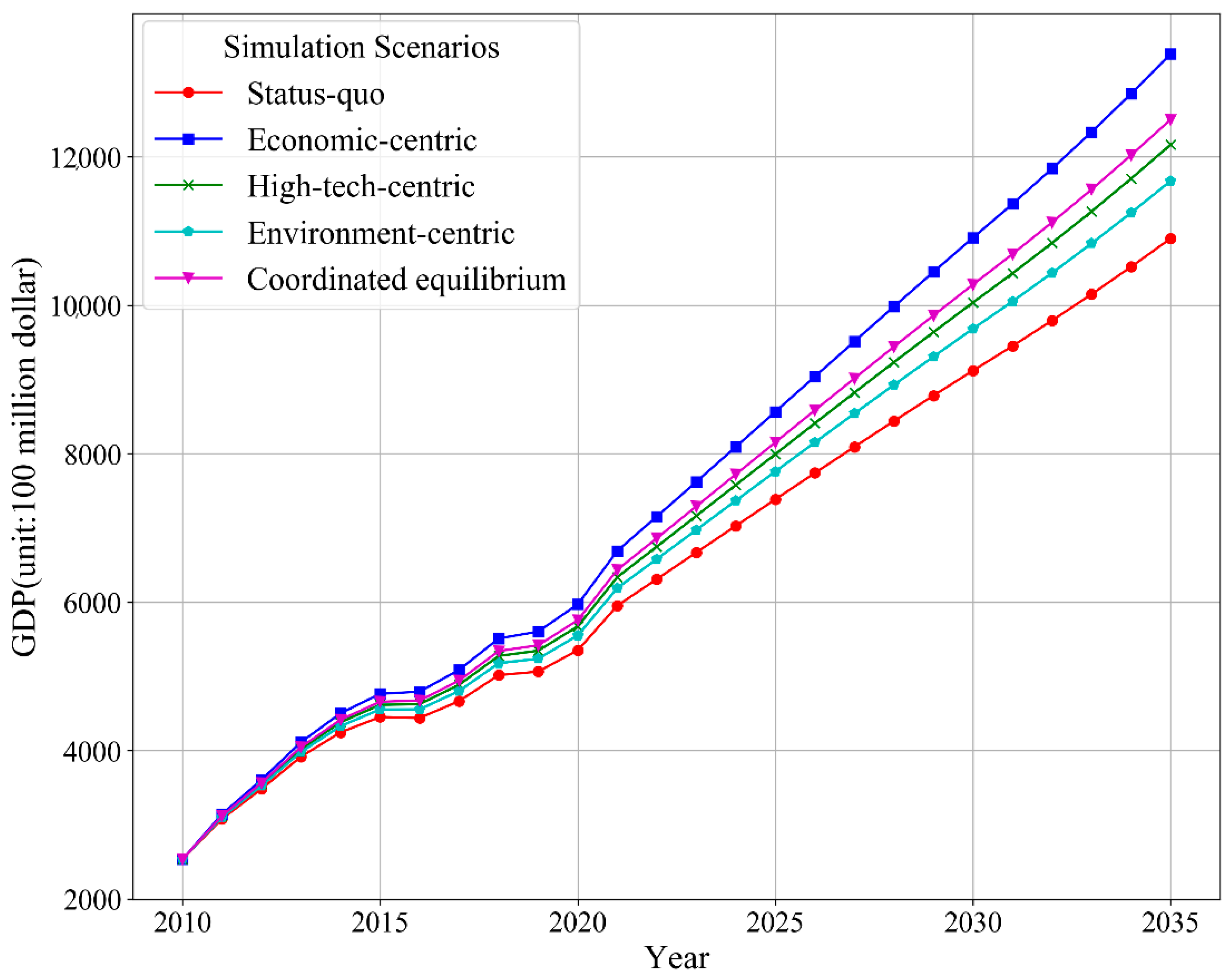
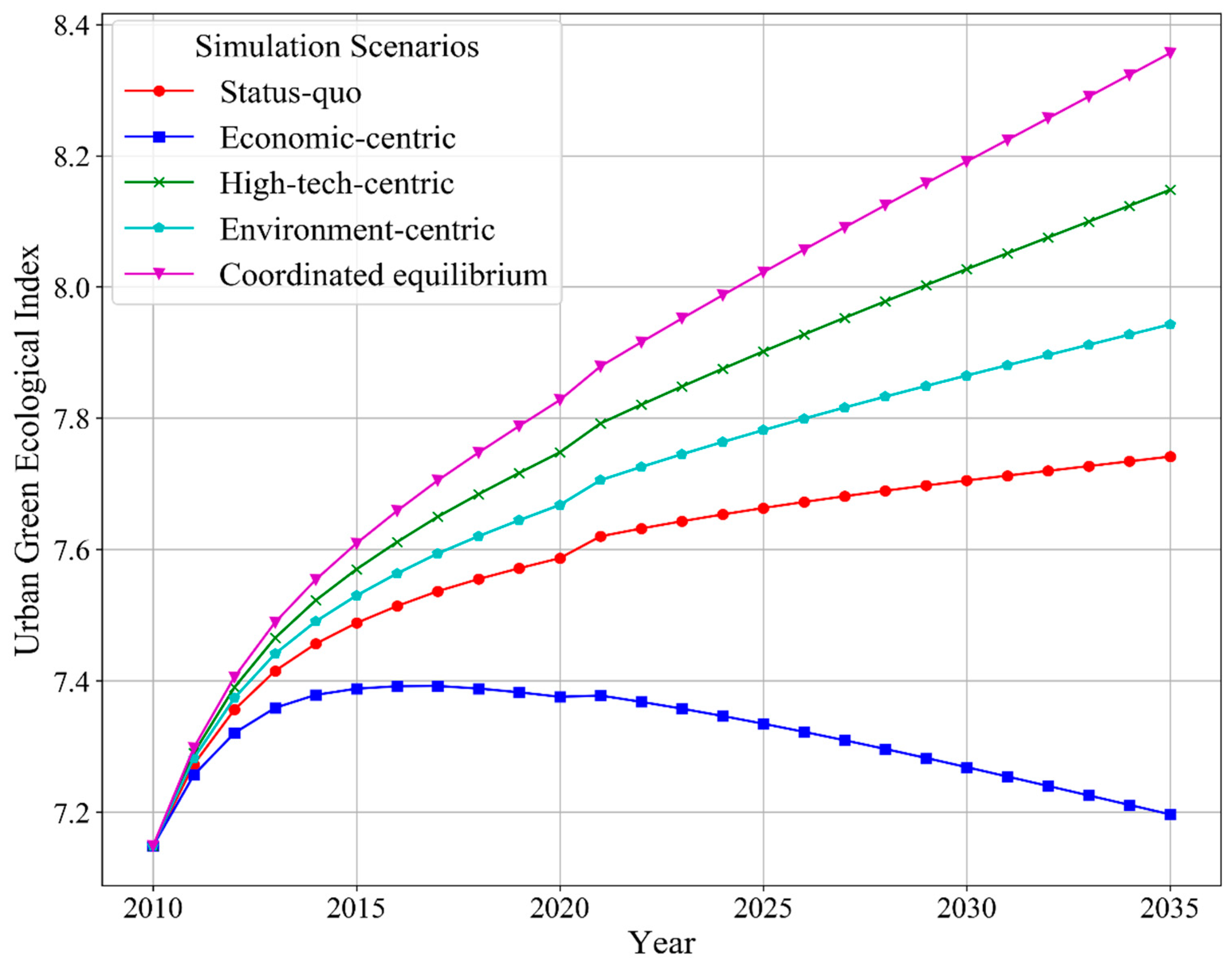
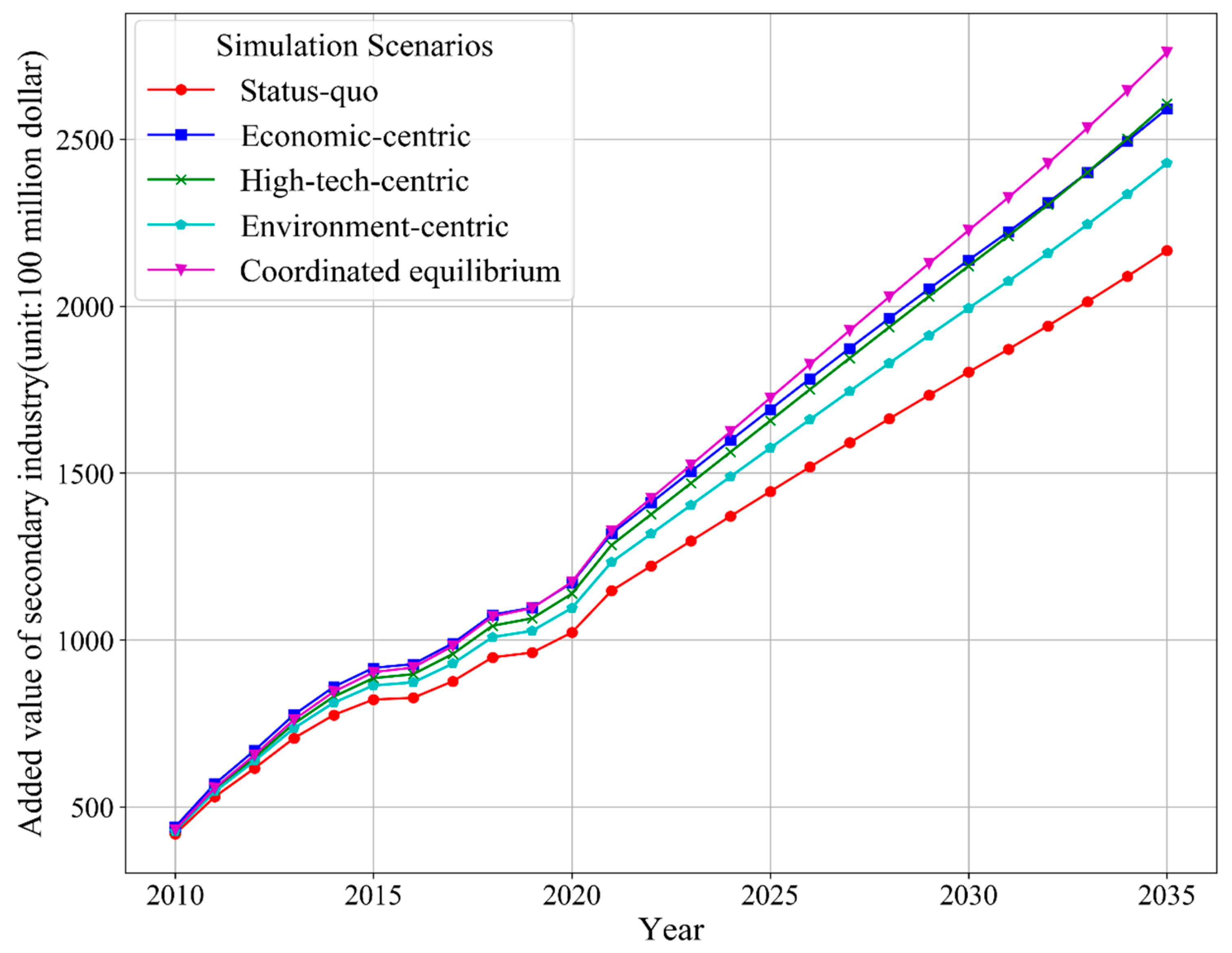
| System Level | Evaluation Indicators | Calculation Equation | Unit | Initial Values |
|---|---|---|---|---|
| Social subsystem | Urban population density | Urban population/built-up area | Ten thousand people/km2 | 0.9239 |
| Social insurance expenditure | Financial revenue × 0.0263 | Yuan | 75.4315 | |
| Number of graduates per year | INTED(Number of graduates per year) + Initial Value | Thousand people | 164 | |
| Education expenditure | Financial revenue × 0.038 | 100 million yuan | 114.943 | |
| Residents’ life index | ln(urban population density + endowment insurance + consumption level of resident + Medical insurance expenditure) | / | 8.79408 | |
| Urban per capita disposable income | GDP × population urbanization rate/urban population | thousand yuan | 31.8 | |
| …… | ||||
| Economic Subsystem | Output value of secondary industry | INTEG (added value of secondary industry) + Initial Value | 100 million yuan | 7139.96 |
| Output value of tertiary industry | INTEG (added value of tertiary industry) + Initial Value | 100 million yuan | 9618.31 | |
| Proportion of high-tech industry output value | SIN (proportion of tertiary industry) | % | 53.145 | |
| GDP | INTEG (GDP increment) + Initial Value | 100 million yuan | 17166 | |
| Scientific and technological achievements | Look up | 0.0502 | ||
| …… | ||||
| Environment subsystem | Green coverage rate of built-up area | Constant (0.31) | / | 0.31 |
| Green area of built-up area | Built-up area × Green coverage rate of built-up area | km2 | 299.7 | |
| Urban green ecological index | 2 × ln(Degree of urban construction + resident’s life index + Habitat quality index + carbon emissions + financial development index) | / | 7.14805 | |
| Total resources | ln(1 + ABS(total water resources + green area of built-up area)) | / | 6.02196 | |
| Sewage discharge | EXP((7.9 × 10−8) * energy consumption + 8) | / | 2438.18 | |
| …… | ||||
| Variables Name | 2010 | 2011 | 2012 | 2013 | 2014 | 2015 | 2016 | 2017 | |
|---|---|---|---|---|---|---|---|---|---|
| Carrying population (Ten thousands) | Historical values | 2303 | 2347 | 2380 | 2415 | 2426 | 2415 | 2420 | 2418 |
| Simulated values | 2303 | 2318 | 2332 | 2346 | 2360 | 2377 | 2387 | 2401 | |
| Error (%) | 0.00 | 1.24 | 2.02 | 2.86 | 2.72 | 1.57 | 1.36 | 0.70 | |
| GDP (100 million yuan) | Historical values | 17,437 | 19,539 | 20,559 | 22,264 | 24,068 | 25,659 | 28,184 | 30,633 |
| Simulated values | 17,166 | 19,902 | 21,998 | 24,277 | 26,083 | 27,729 | 29,487 | 31,526 | |
| Error (%) | 1.55% | 1.86% | 7.00% | 9.04% | 8.37% | 8.07% | 4.62% | 2.92% | |
| Output value of the tertiary industry (100 million yuan) | Historical values | 9833 | 11,143 | 12,199 | 13,786 | 15,276 | 17,275 | 19,663 | 21,191 |
| Simulated values | 9618 | 11,300 | 13,139 | 15,099 | 16,170 | 17,309 | 18,520 | 19,821 | |
| Error (%) | 2.19% | 1.41% | 7.71% | 9.52% | 5.85% | 0.20% | 5.81% | 6.47% | |
| Urban green ecological index | Historical values | 7.148 | 7.272 | 7.356 | 7.415 | 7.456 | 7.488 | 7.513 | 7.536 |
| Simulated values | 7.148 | 7.297 | 7.405 | 7.489 | 7.554 | 7.609 | 7.659 | 7.705 | |
| Error (%) | 0 | −0.3% | −0.7% | −1.0% | −1.3% | −1.6% | −1.9% | −2.3% | |
| Scenarios | Ranking Results | |||
|---|---|---|---|---|
| Carrying Population | GDP | Green Ecological Index | Added Value of Secondary Industry | |
| Status quo | 5 | 5 | 4 | 5 |
| economic-centric | 1 | 1 | 5 | 3 |
| high-tech | 3 | 3 | 2 | 2 |
| environment-centric | 4 | 4 | 3 | 4 |
| coordinated equilibrium | 2 | 2 | 1 | 1 |
Publisher’s Note: MDPI stays neutral with regard to jurisdictional claims in published maps and institutional affiliations. |
© 2022 by the authors. Licensee MDPI, Basel, Switzerland. This article is an open access article distributed under the terms and conditions of the Creative Commons Attribution (CC BY) license (https://creativecommons.org/licenses/by/4.0/).
Share and Cite
Yu, W.; Tao, T. Scenario Simulation for the Urban Carrying Capacity Based on System Dynamics Model in Shanghai, China. Sustainability 2022, 14, 12910. https://doi.org/10.3390/su141912910
Yu W, Tao T. Scenario Simulation for the Urban Carrying Capacity Based on System Dynamics Model in Shanghai, China. Sustainability. 2022; 14(19):12910. https://doi.org/10.3390/su141912910
Chicago/Turabian StyleYu, Wenlong, and Tianhui Tao. 2022. "Scenario Simulation for the Urban Carrying Capacity Based on System Dynamics Model in Shanghai, China" Sustainability 14, no. 19: 12910. https://doi.org/10.3390/su141912910
APA StyleYu, W., & Tao, T. (2022). Scenario Simulation for the Urban Carrying Capacity Based on System Dynamics Model in Shanghai, China. Sustainability, 14(19), 12910. https://doi.org/10.3390/su141912910








